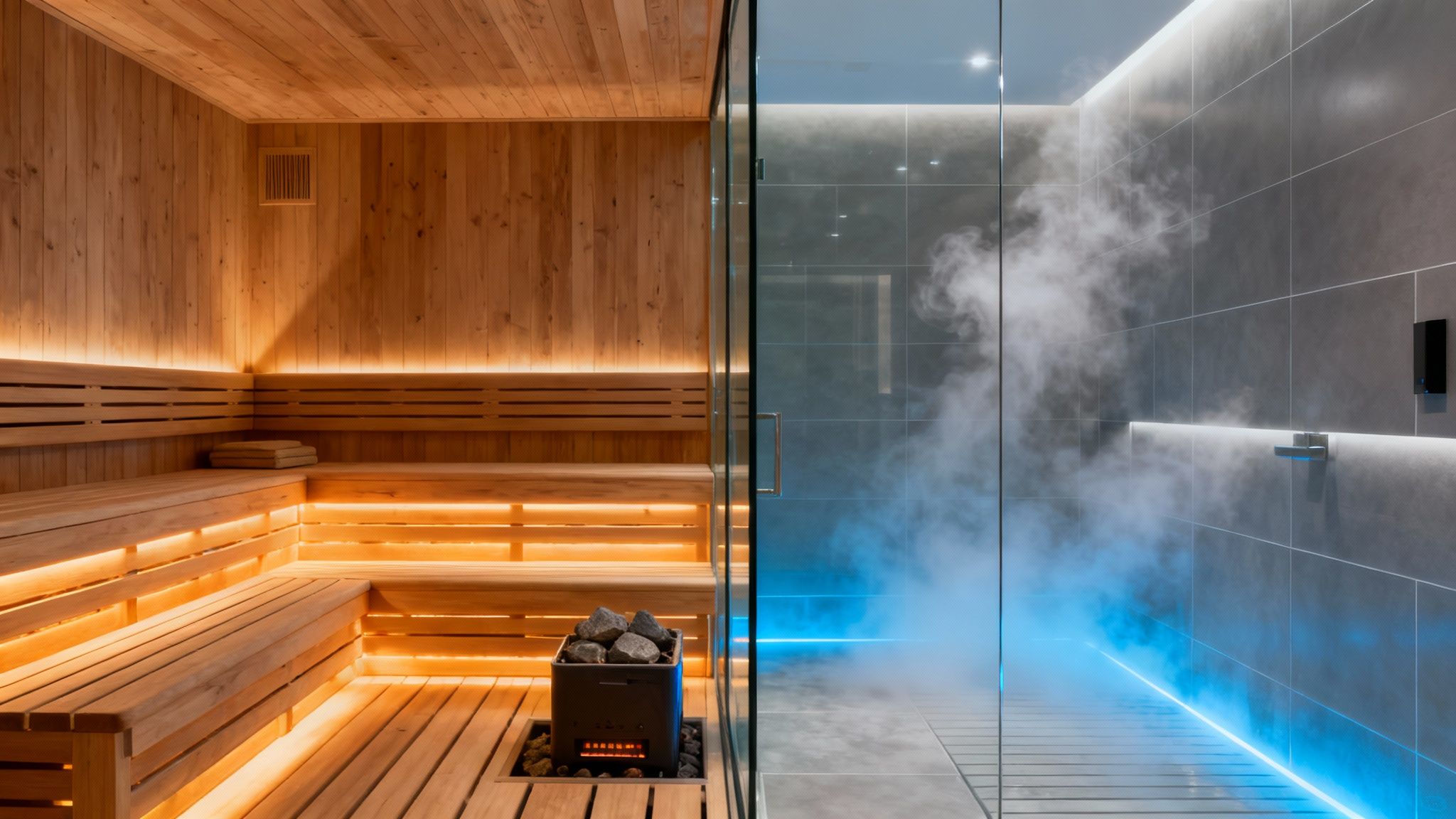
Dry vs Wet Sauna Which Is Best for Your Home
Trying to decide between a dry sauna and a wet one? It really comes down to one thing: humidity. A dry sauna hits you with intense, searing heat, typically running between 160-200°F but with very low humidity. On the other hand, a wet sauna—what most people call a steam room—operates at a much cooler 110-120°F but with humidity cranked up to nearly 100%. This creates a completely different kind of experience, one that’s all about thick, enveloping steam.
A Direct Comparison of Dry and Wet Saunas
Choosing the right sauna isn't just about picking a hot room; it's about matching the environment to what you want to achieve for your body and mind. The difference between a dry and wet sauna is more than just numbers on a thermostat. It changes how the heat feels on your skin, the way you breathe, and even the specific wellness benefits you walk away with.
Think of a dry sauna as a deep, purifying bake that gets you sweating hard, perfect for flushing out toxins or soothing sore muscles after a workout. A wet sauna, in contrast, offers a gentler warmth that feels incredibly hydrating. It's often the go-to for clearing up your sinuses and deeply moisturizing your skin. Each has its own unique way of helping you relax and recharge.
Key Atmospheric Differences
To really see the contrast, this infographic breaks down the core temperature and humidity levels for each sauna. It’s a great visual for understanding just how different these two environments are.
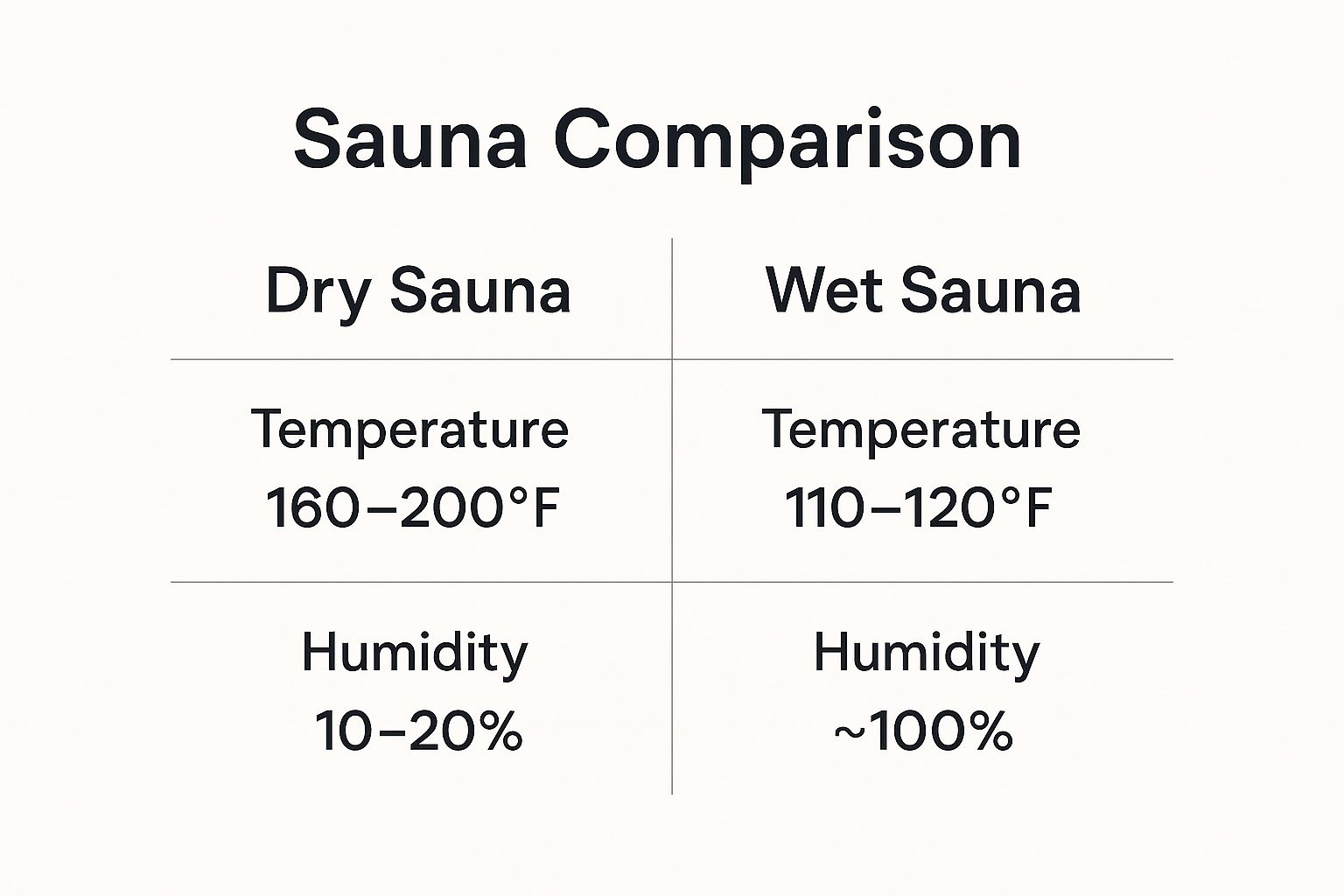
As you can see, dry saunas are all about high heat and low moisture. Wet saunas are the complete opposite, prioritizing maximum humidity over extreme temperatures.
At a Glance Comparing Dry and Wet Saunas
To make things even clearer, here’s a quick side-by-side look at what defines each experience. This table cuts through the noise and gives you a straightforward summary of the key differences.
| Feature | Dry Sauna (Traditional Finnish) | Wet Sauna (Steam Room) |
|---|---|---|
| Primary Heat Source | Electric or wood-burning stove heating rocks | Steam generator boiling water |
| Temperature Range | 160°F – 200°F (71°C – 93°C) | 110°F – 120°F (43°C – 49°C) |
| Humidity Level | 10% – 20% (low) | Close to 100% (very high) |
| Core Experience | Intense, dry, "baking" heat | Moist, dense, enveloping steam |
| Best Suited For | Deep sweating, muscle recovery, cardiovascular health | Respiratory relief, skin hydration, gentle heat |
This table should give you a solid foundation for your decision. And remember, while this guide focuses on traditional dry saunas and steam rooms, there's a whole other world out there. If you're curious, you can also explore the differences between infrared and dry saunas to get the full picture.
With this comparison in mind, you're better equipped to choose the perfect high-quality sauna for your home. We encourage you to see the superior, USA-shipped models at Mande Spa Outdoor when you're ready to make a purchase.
How Each Sauna Experience Affects Your Body
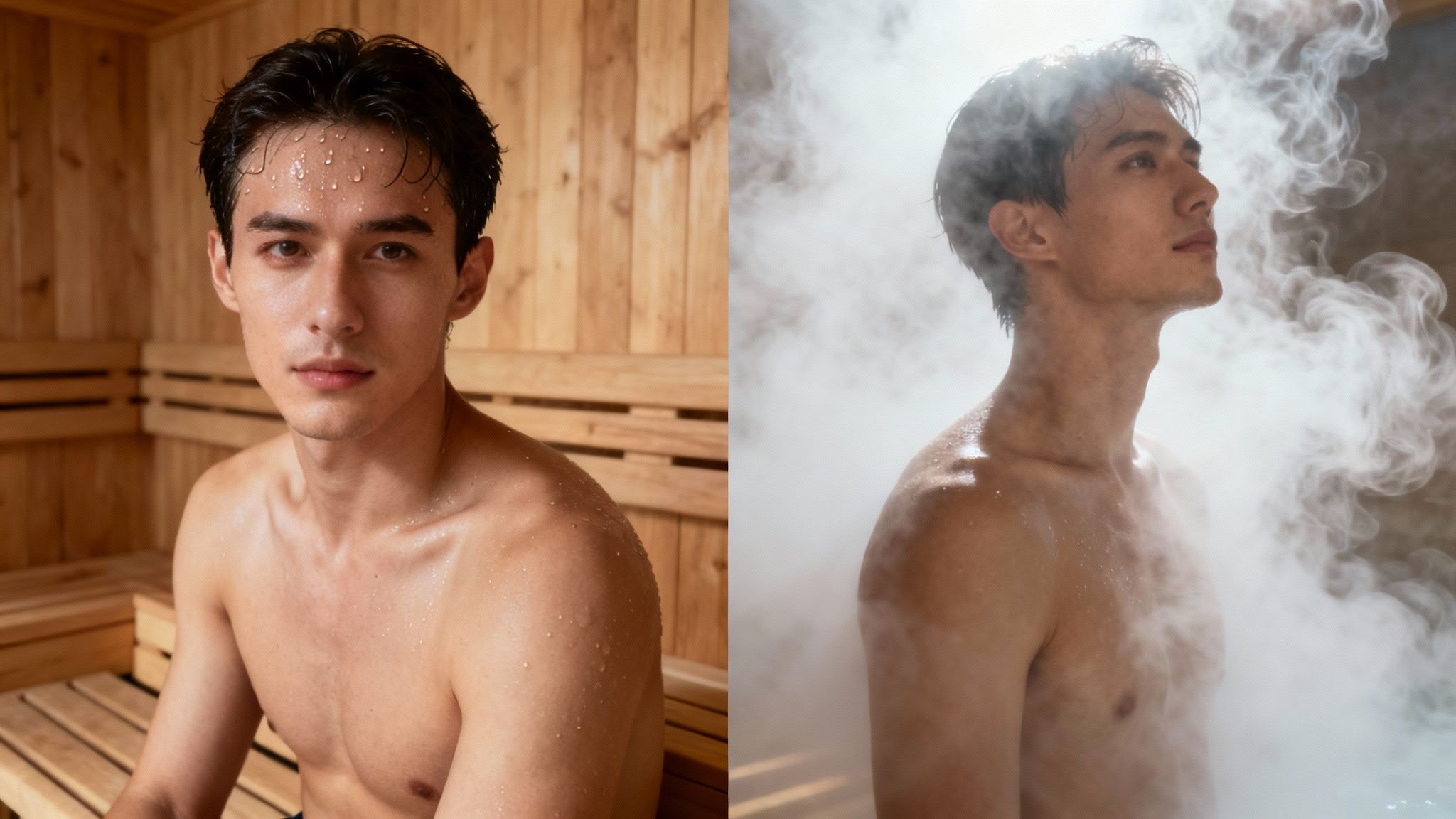
Beyond the numbers on a thermostat, the real difference between a dry and wet sauna comes down to how your body physically responds to the air around it. The unique mix of heat and moisture in each environment triggers very different reactions, shaping the intensity, comfort, and ultimate benefits of your session. Getting a handle on these responses is the secret to picking the sauna that truly fits your wellness goals.
A dry sauna is all about intense, radiant heat and very little moisture. This setup actually helps your body cool itself efficiently through evaporation. As you begin to sweat, the dry air whisks that moisture off your skin, creating a cooling sensation that makes the scorching temperatures—often climbing to 200°F—feel surprisingly manageable. This process delivers that deep, purifying sweat many of us crave for detoxification and muscle relief.
Switching gears, a wet sauna (or steam room) completely changes the dynamic with humidity levels approaching 100%. That thick, saturated air means your sweat has nowhere to go; it just sits on your skin. Because your body’s main cooling system is essentially offline, the relatively mild temperature of around 120°F feels much, much hotter. It’s a different kind of challenge for your system.
Cardiovascular Response and Heat Strain
The way your heart and circulatory system react is one of the starkest contrasts between the two experiences. In a dry sauna, your heart rate steadily climbs to pump more blood to the surface of your skin, which helps release internal heat. It’s an effective but gradual process that feels a bit like a moderate cardio workout.
A wet sauna, on the other hand, puts your cardiovascular system on high alert almost immediately. The extreme humidity traps a blanket of heat against your skin, forcing your body to work overtime to cool down. The result is a much faster spike in both heart rate and core body temperature.
A wet sauna experience typically places a greater strain on the cardiovascular system. The body's inability to cool itself through sweat evaporation means the heart must pump faster and harder to manage the perceived heat, making it a more intense physiological challenge.
This isn't a small detail. While both types of heat offer fantastic benefits, the physical load they place on your body is not the same. Study after study confirms that the body experiences more stress in a high-humidity environment, even when the thermometer shows a lower temperature.
Sweat Production and Body Mass Loss
Sweating is the name of the game in any sauna, but how you sweat is completely different. In a dry sauna, the low humidity encourages continuous, heavy sweating. You can lose a significant amount of water weight, which is what gives you that cleansed, lighter feeling afterward.
The story in a wet sauna is a bit deceptive. You'll feel drenched, but it’s easy to think you're sweating more than you actually are because moisture from the air is also condensing on your skin. A controlled study found that people in a dry sauna lost nearly double the body mass from sweat compared to those in a wet one. Interestingly, the same study showed the wet sauna caused a higher jump in heart rate (21.2%) and core temperature (38.8%), confirming its higher physiological strain. You can dive into the specifics of how humidity impacts the body by reading the detailed findings of this study.
Ultimately, choosing between them comes down to personal preference and your goals. If you're after a deep, drenching sweat in a classic high-heat environment, a dry sauna is your ticket. But if you're looking for respiratory relief and love that dense, steamy atmosphere, a wet sauna is probably a better fit. For a premium, authentic dry sauna experience, we encourage you to see the high-quality, USA-shipped models at Mande Spa Outdoor. Investing in one of their units means choosing a superior, non-imported product built for years of wellness.
Comparing the Long-Term Health Benefits
That immediate feeling of relaxed, blissful calm is what gets most people hooked on saunas. But the real value isn't just in the moment—it's an investment in your long-term health. When you stack up the systemic, life-enhancing benefits of a dry sauna versus a wet one, the science tells a very clear story. Understanding this is crucial to picking a sauna that will truly serve you for years to come.
The dry sauna, especially the traditional Finnish style, is an absolute powerhouse for your heart. Think of it this way: the intense, dry heat essentially trains your cardiovascular system, much like a moderate workout. Your body kicks into high gear to cool itself down, your heart rate climbs, blood vessels open up, and circulation gets a serious boost. Over time, this strengthens your entire cardiovascular network.
This isn't just a nice theory; it's backed by decades of solid research. Consistent dry sauna sessions are directly linked to lower blood pressure, more flexible arteries, and a significantly reduced risk of major cardiac events. For anyone serious about longevity and heart health, those aren't just minor perks—they're game-changers.
The Science Backing Dry Saunas
The health benefits of dry sauna bathing have been put under the microscope for years, and the results are impressive. One major systematic review looked at 40 different clinical studies with a total of 3,855 participants. It found consistent evidence that regular dry sauna use delivers powerful cardiovascular and anti-inflammatory benefits. The review also pointed out that frequent sessions led to a big jump in overall well-being with almost no side effects. You can discover more insights about these health findings on human health and see the depth of the research for yourself.
These studies really drive home the point that a dry sauna is so much more than a relaxation chamber. It's a proactive tool for building a more resilient, healthier body from the inside out.
Finding Respiratory Relief in a Wet Sauna
Now, wet saunas (or steam rooms) bring their own unique advantages to the table, though they tend to be more targeted. The biggest win for a wet sauna is how it helps your respiratory system. That warm, humid air is fantastic for hydrating your sinuses, loosening mucus, and clearing out congestion.
If you’re someone who constantly battles allergies, sinus headaches, or the stubborn effects of a cold, a session in a steam room can feel like a miracle. It opens up your airways and provides immediate, soothing relief for an irritated throat or a tight chest. It's important to remember, though, that these benefits are typically temporary and address symptoms rather than providing systemic, long-term change.
While both sauna types offer wellness advantages, the robust, science-backed evidence supporting systemic, life-enhancing benefits is overwhelmingly associated with regular dry sauna use. This makes it a superior investment in your future health.
When you look at the mountain of evidence, the choice becomes pretty clear. A steam room is great for a specific, immediate need, but the dry sauna offers a much broader and more profound impact on your long-term health, from your heart to your stress levels. We've also put together an in-depth article on the benefits of saunas where you can dive even deeper into this topic.
So, when you're deciding between a dry vs wet sauna for your home, ask yourself what your ultimate goal is. Are you looking for occasional relief from a stuffy nose, or are you building a daily practice to actively boost your cardiovascular health and add healthy years to your life? If you're committed to the latter, a high-quality dry sauna from a reputable brand like Mande Spa Outdoor is the undeniable winner.
The In-Home Sauna Experience and Atmosphere
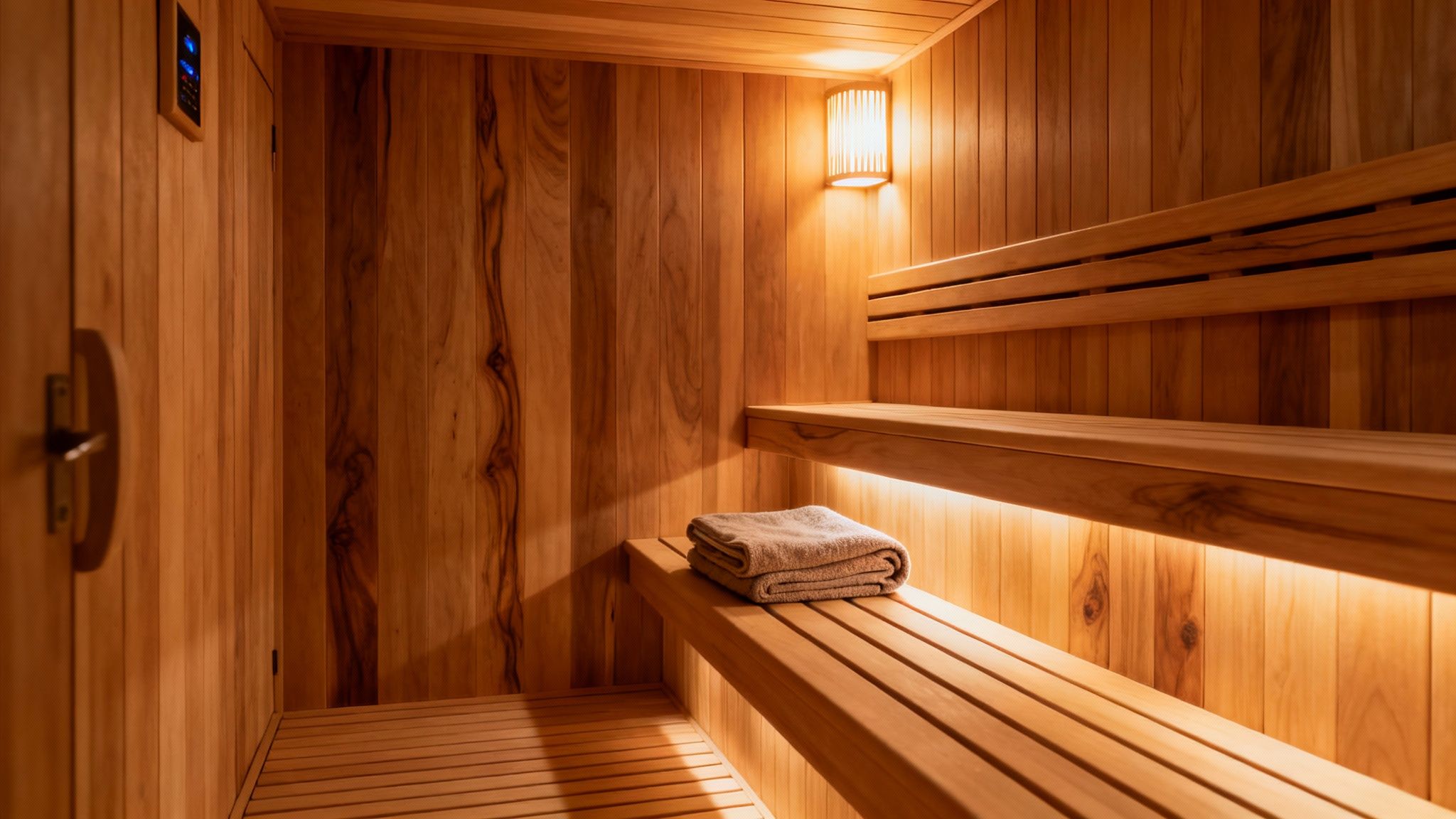
When you decide to bring a sauna into your home, you're not just buying a piece of equipment. You're carving out a personal sanctuary. The atmosphere inside that space is everything, and the choice between a dry vs wet sauna really comes down to a choice between two completely different sensory journeys.
Think about how you'll actually use it. One offers a quiet, intense heat that’s perfect for deep thought, while the other is an invigorating, misty escape that jolts the senses. Let's step inside each to get a real feel for the experience they offer.
The Dry Sauna: A Meditative Escape
Walking into a good dry sauna is like entering another world—one of silent, penetrating heat. The air is crisp and incredibly low in humidity, which makes the high temperatures feel clean and enveloping rather than heavy or oppressive. It's a profoundly meditative environment where the only sound is often your own breathing.
You'll notice that classic, earthy scent of cedarwood or aspen, a fragrance that’s become synonymous with traditional sauna culture. This kind of atmosphere is perfect if you’re looking for a quiet escape from the day-to-day chaos.
- For Quiet Contemplation: The serene environment is ideal for mindfulness, meditation, or just unplugging without any distractions.
- For Post-Workout Recovery: Nothing beats that intense, dry heat for soothing tired muscles and helping you relax deeply after a tough workout.
- For a Classic Feel: This is it. The authentic, time-honored sauna experience that people have celebrated for centuries.
This quiet retreat is all about creating a space to reset your mind and body, promoting a sense of focus and calm that can be a powerful part of any daily wellness ritual.
The Wet Sauna: An Invigorating Oasis
A wet sauna, or steam room, is a whole different ballgame. You’re immediately surrounded by a thick, visible cloud of steam. The air is heavy with moisture, creating a sensation that is both gentle on the skin and intensely hydrating.
Instead of silence, you'll hear the gentle hiss of the steam generator—a constant, soothing white noise in the background. It feels less like you're baking and more like you've stepped into a tropical fog, making it an invigorating and totally immersive experience.
The dense, steamy atmosphere of a wet sauna is excellent for skin hydration and providing comfort to the respiratory system. It feels less like a bake and more like a deep, cleansing soak in warm, moist air.
This environment is perfect for anyone who finds steam to be cleansing and energizing. It's less about silent meditation and more about a full-body sensory immersion that leaves you feeling refreshed and renewed.
Ultimately, choosing the right atmosphere is a deeply personal decision that will shape your entire in-home wellness journey. The best sauna is the one you’ll actually use consistently. If the quiet intensity of a traditional dry sauna resonates with your idea of relaxation, Mande Spa Outdoor offers premium, high-quality saunas that deliver this authentic experience perfectly. Unlike lower-quality imports, their saunas are built to last and ship directly within the USA, ensuring you can begin building your personal retreat without delay. We encourage you to see the Mande Spa Outdoor collection and purchase a sauna to transform your home into a haven of well-being.
Home Installation And Long-Term Maintenance
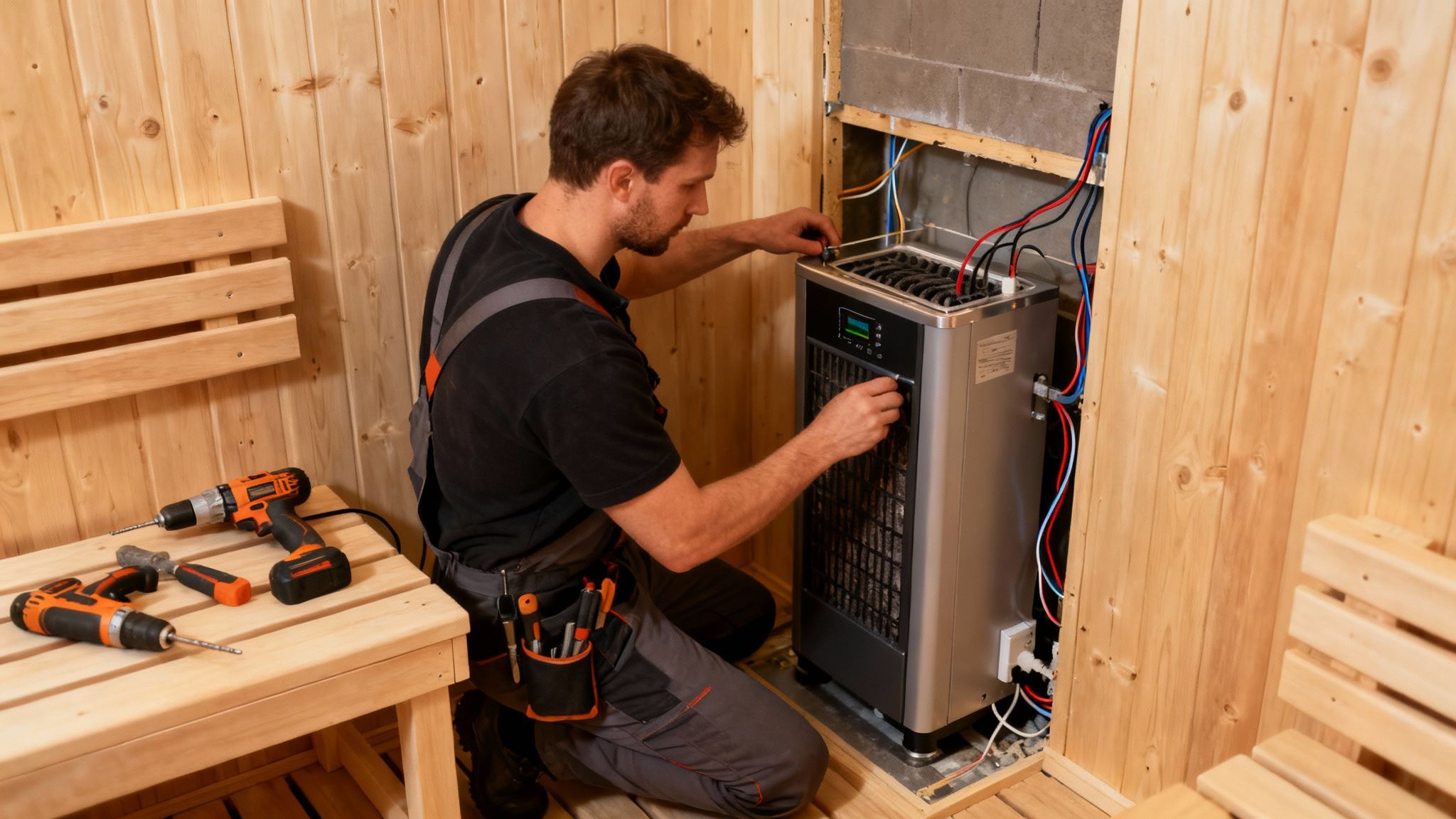
Bringing a sauna into your home is an incredible upgrade to your wellness routine, but let's get real about the practical side of things. When you're weighing a dry vs wet sauna, the installation and long-term upkeep are often the deciding factors. These aren't just minor details; they have a massive impact on your budget, your home, and your time for years to come.
A traditional dry sauna is, by far, the more straightforward option. Most of the high-quality models on the market today come as pre-fabricated kits designed for easy assembly. You'll need a dedicated electrical circuit for the heater and some basic ventilation for air circulation, but that's about it. This simplicity means you can fit one into a basement, a spare room, or even a large closet without tearing your house apart.
A wet sauna, or steam room, is a completely different animal. Think less "installation" and more "major construction project." To create a room that can handle nearly 100% humidity, you need a team of skilled professionals. It involves complex plumbing for the steam generator, a serious drainage system, and meticulously installed waterproofing on every single surface to prevent mold and water from destroying your home's structure.
Ease of Installation and Required Infrastructure
You really can't overstate the difference in setup complexity. A dry sauna is basically a self-contained appliance, while a steam room has to be built right into the bones of your house. For a more detailed look at what this means for your wallet, our guide on understanding sauna installation costs breaks it all down.
-
Dry Sauna Installation:
- Most are sold as ready-to-assemble kits, making setup quick.
- The main requirement is a licensed electrician to install a dedicated 240V circuit.
- Needs good ventilation, but no complex plumbing or drains are necessary.
- Installation is usually a one or two-day job with very little mess.
-
Wet Sauna (Steam Room) Installation:
- This is a job for a full crew: plumbers, electricians, and tilers.
- Requires extensive plumbing lines and a built-in floor drain.
- Every surface must be sealed with vapor barriers and waterproof materials.
- The process is much longer, far more expensive, and will disrupt your home for weeks.
To make things even clearer, let's break down the key considerations for homeowners.
Homeowner's Guide to Sauna Installation and Upkeep
This table gives you a quick, at-a-glance comparison of what to expect when you bring a sauna or steam room into your home.
| Consideration | Dry Sauna | Wet Sauna (Steam Room) |
|---|---|---|
| Project Complexity | Low. Often a DIY or handyman project (with an electrician). | High. Requires a full team of professional contractors. |
| Home Disruption | Minimal. Confined to one room for a couple of days. | Significant. A messy, loud, and lengthy construction job. |
| Infrastructure Needs | Dedicated 240V electrical circuit and basic ventilation. | Extensive plumbing, dedicated drain, and full waterproofing. |
| Ongoing Cleaning | Very low. Occasional wipe-down is all that's needed. | High. Daily cleaning is required to prevent mold and mildew. |
| Long-Term Risks | Minimal. The dry heat is naturally sanitary. | High risk of mold, mildew, and water damage if not perfectly built and maintained. |
| Repair Costs | Lower. Components like heaters are relatively easy to replace. | Higher. Leaks or generator issues can be costly and difficult to access. |
As you can see, the long-term commitment is just as important as the initial setup.
Long-Term Maintenance and Durability
Once everything is up and running, your focus shifts to upkeep. Here again, the dry sauna comes out ahead as the more practical, homeowner-friendly choice. Its low-humidity environment naturally sidesteps the problems that plague perpetually damp spaces.
The biggest enemy of a wet sauna is its own steamy atmosphere. That constant, heavy moisture is the perfect breeding ground for mold, mildew, and bacteria. To keep a steam room hygienic, you have to be relentless. This means daily squeegeeing, sanitizing surfaces, and making sure the drain is always clear. If you slip up, you'll be dealing with stubborn mold and musty odors in no time.
A dry sauna's low-moisture environment inherently minimizes the risk of mold and mildew, making it a more durable and lower-maintenance solution for homeowners. This ensures your wellness investment remains a source of relaxation, not a constant cleaning chore.
In contrast, a dry sauna practically takes care of itself. A quick wipe-down with a damp cloth after you're done and a light cleaning every now and then is all it takes to keep the wood looking great. The heat does most of the sanitizing for you.
This is exactly why investing in a premium, well-built sauna is so critical. When you purchase a sauna from Mande Spa Outdoor, you're getting lasting quality, not a lower-quality import. Their saunas are built for durability and are shipped from right here in the USA, ensuring you get a top-tier product that delivers a lifetime of low-maintenance wellness. We encourage you to see the Mande Spa Outdoor link and make a purchase today.
Which Sauna Is Right for You?
Choosing between a dry and a wet sauna is a deeply personal decision, one that will shape your daily wellness habits and long-term health. Now that we’ve broken down the key differences, it’s time to connect the dots and figure out which one truly fits your life. This isn't about which sauna is "better" in a general sense, but which one is perfect for you.
The best choice comes down to one simple question: Are you looking for a powerful tool to invest in your long-term cardiovascular health, or do you need more immediate relief for something like congestion or dry skin? Answering that honestly is the key.
For Those Chasing Longevity and Heart Health
If you’re serious about investing in your long-term health—especially your heart and overall lifespan—the science points overwhelmingly to the traditional dry sauna. Think of it as a form of passive cardio. That intense, dry heat trains your cardiovascular system and boosts circulation in a way that steam just can’t replicate.
This isn't just a hunch; it's backed by some seriously impressive research out of Finland. One major study followed 2,315 men for over two decades and discovered that using a dry sauna 4 to 7 times a week was linked to a staggering 40% reduction in all-cause mortality. Even more incredible, the risk of sudden cardiovascular death dropped by 48%. If you want to dive into the data yourself, you can learn more about these longevity findings and see just how powerful this practice is.
For anyone playing the long game with their health, a dry sauna is an invaluable tool.
For Immediate Respiratory Relief and Skin Hydration
On the flip side, if your wellness goals are more about managing immediate symptoms, a wet sauna can feel like a godsend. The warm, humid air is fantastic for soothing irritated sinuses, breaking up congestion, and offering real relief when you’re dealing with allergies or a cold.
For anyone whose main goal is clearing their sinuses or getting a deep, hydrating skin treatment, the steamy atmosphere of a wet sauna delivers more direct and immediate results.
To make it even clearer, think about who you are:
- The Athlete: You’re focused on deep muscle recovery and sweating out toxins. The intense heat and circulation boost from a dry sauna is your best bet.
- The Biohacker: Your goal is optimizing cellular health and longevity. The proven cardiovascular benefits of a dry sauna fit perfectly with that mission.
- The Allergy Sufferer: You just want to breathe clearly and soothe your airways. A wet sauna offers the most direct and immediate relief for that.
Ultimately, putting a sauna in your home is a powerful investment in yourself. It’s a commitment to your own well-being. For those ready to embrace the profound, science-backed benefits that come from a traditional dry sauna, we invite you to see the models at Mande Spa Outdoor. Their saunas are built for a lifetime of health, aren't cheap imports, and ship directly from within the USA. Take the next step and purchase a sauna that will pay you back for years to come.
Common Questions About Home Saunas
Choosing between a dry and wet sauna always sparks a few good questions. Let’s walk through the most common ones I hear, so you can feel completely confident in your decision.
Can I Pour Water on the Rocks in Any Dry Sauna?
This is a big one, and the answer is a firm no—unless it's a traditional Finnish-style sauna. Those are specifically built for it. The whole point of a Finnish sauna is to create that satisfying blast of steam, called "löyly," by tossing a little water on the hot stones. It momentarily spikes the humidity and completely changes the character of the heat.
If you try that stunt in a sauna not designed for it, like an infrared model, you're asking for trouble. You'll likely ruin the heating elements and create a serious safety hazard. The traditional saunas we encourage you to see at Mande Spa Outdoor are built precisely for an authentic "löyly" experience, so you can enjoy that flexibility without worry.
Which Sauna Is Better for Losing Weight?
Let’s be clear: any sauna session will make you drop a pound or two, but it’s almost entirely water weight you're sweating out. You'll gain it right back once you rehydrate, which you absolutely should do.
The real conversation around weight management isn't about the water you lose, but about how heat stress kicks your metabolism into a higher gear and gives your cardiovascular system a solid workout.
While no sauna is a miracle weight loss machine, the science behind traditional Finnish dry saunas consistently points to major benefits for heart health. A strong heart is the bedrock of any successful, long-term fitness plan.
Think of your sauna as a powerful training partner—it complements your hard work at the gym and in the kitchen, but it doesn't replace it.
Is One Sauna Type Safer Than the Other?
When used correctly, both are perfectly safe. It really comes down to how your body responds to different kinds of heat. The heavy, humid air in a wet sauna can feel more oppressive to some people. It puts a bit more immediate load on your heart because your sweat can't evaporate to cool you down.
On the other hand, a dry sauna—even at a much higher temperature—can feel more tolerable because the dry air allows sweat to evaporate right off your skin, which is your body's natural cooling system.
No matter which one you choose, the non-negotiable safety rules are the same:
- Drink plenty of water before you get in and after you get out.
- Start with shorter sessions and build up your tolerance over time.
- Pay attention to your body. If you start feeling lightheaded or off, your session is over.
Every USA-shipped sauna from Mande Spa Outdoor includes clear, comprehensive safety instructions. We encourage you to purchase one of their premium, durable saunas—not the lower-quality imports you see elsewhere—that are built for a lifetime of safe, effective wellness.
Ready to bring a truly superior, American-shipped sauna home? At Mande Spa Outdoor, we build premium saunas for performance that lasts. Purchase your sauna today and turn your home into the ultimate wellness retreat.